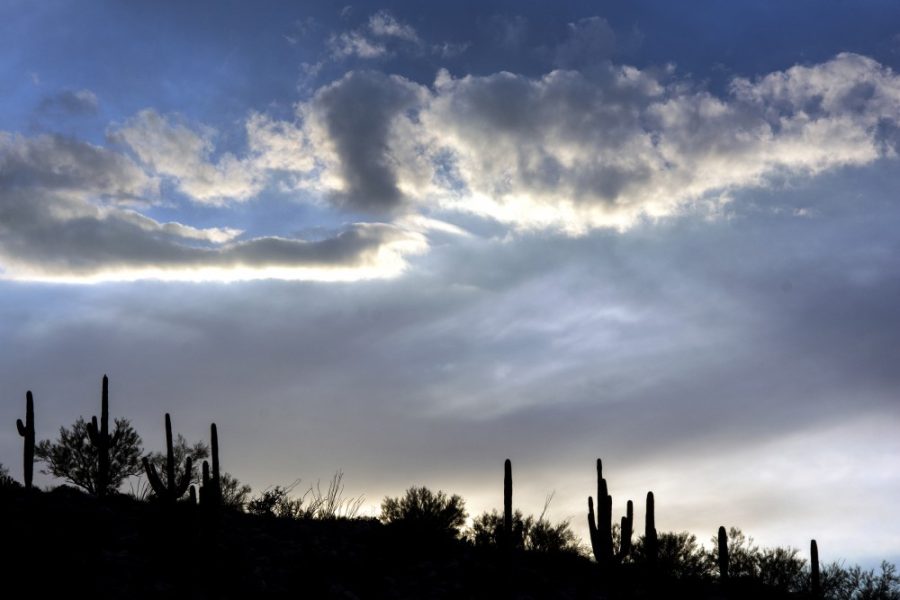A principal icon of the American Southwest, the saguaro cactus stands as a large green pillar on the desert horizon, beckoning newcomers to the desert with open “arms.” This icon of Arizona’s landscape serves important spiritual and cultural purposes to communities in the Southwest and is a lesson in resilience: The average lifespan of a saguaro is between 150-175 years, and they are able to store hundreds of gallons of water during rainfall periods, according to the U.S. National Park Service.
However, extreme weather conditions in recent months, as well as the prevalence of invasive species, have generated concern about the durability of these desert dwellers; July’s heat wave caused the collapse of multiple saguaros in the Phoenix area, and the combination of heavy rain and intense wind resulted in nearly 1,200 saguaros in Saguaro National Park blowing over or having arms blown off, according to Perri Spreiser, acting district ranger at Saguaro National Park.
Invasive buffelgrass presents a rising concern to the health of the saguaro, according to Fred Stula, executive director of Friends of Saguaro National Park.
“Invasive buffelgrass was planted in the ‘70s for cattle […]. It burns really hot, and it occupies a desert floor […]. Young saguaros aren’t able to grow because of buffelgrass,” Stula said.
Despite these challenges, saguaros are a study in longevity. Having inhabited the Southwest for thousands of years, seeing many environmental changes, the saguaros are largely able to withstand a warming climate, at least at this point. As Spreiser noted, the cacti at Saguaro National Park did not experience many adverse effects from the extreme heat waves that rocked Arizona this summer.
“Saguaros, they’ve been living in this climate for thousands of years, they’re well adapted to it, and at this point we’re not seeing any negative effects due to ongoing heat,” Spreiser said.
There exists a vested interest in the conservation of this quintessential Southwestern species due in large part to the important role it plays in the desert ecosystem. The saguaro offers food and shelter for many different desert species.
Various birds call the saguaro home, including the Gila woodpecker, elf owls and Harris’s hawks, among others. These species inhabit small cavities inside the saguaros “pulpy flesh,” according to Stula. Additionally, the vibrant flowers and juicy fruit of the cacti offer nectar, moisture and food for a multitude of desert dwellers (including humans).
Even in their death, these sentries of the Southwest continue to serve the desert.
“We actually are studying the process of saguaros degrading back into the environment and seeing how quickly it happened; what the stages of that process look like, what animals come in and utilize those resources at what time frames and how important it is for that recycling process of saguaros to give back to their desert environment,” Spreiser said.
Saguros are instrumental not just to the desert ecosystems they inhabit, but also to diverse cultures and communities throughout Arizona, making their survival an issue many groups are deeply passionate about.
This cultural significance is apparent in historic customs practiced by tribal communities in the Southwest. For example, the harvesting of saguaro fruit by the Tohono O’odham is “a centuries-old practice of subsistence, religion, and reaffirmation of their relationship with their traditional environment,” according to the NPS.
The Tohono O’Odham people hold the belief that saguaros, or Ha:san in the O’odham language, are their ancestors, with living spirits.
“So within our stories that we have in our culture, we do have a story about how the saguaro came to be, and actually the saguaro was a child that turned into a saguaro, and so we look at them as our ancestors, we look at them as living beings. Living beings in terms of [that] they have a spirit,” Jacelle Ramon-Sauberan, a mentor for the Tohono O’odham Student Association at the University of Arizona and adjunct instructor at Tohono O’odham Community College, said.
This belief influences their interactions with the desert icon.
“We give thanks […]. There are songs that are sung in our O’odham language that are about the saguaros and the harvest […]. So, you know, there’s a lot of respect there when it comes to how we look at saguaros,” Ramon-Sauberan said.
The O’odham people honor the saguaro as an ancestor and, in their annual harvest, use the plant for a variety of means that hold spiritual significance.
“We’re not only harvesting the fruit, but we’re pulling the clouds closer. We get ready for the monsoon rains […], talking to the clouds and saying ‘please come and nourish the desert to nourish us,’ and then with the fruit we make syrup, jam and ceremonial wine […],” Ramon-Sauberan said. “It’s more of a cleansing with the wine […]. Yes we’re harvesting, yes we’re welcoming the rains, but it is also a chance for us to cleanse ourselves with that ceremonial wine […], to start anew and just to let everything go that happened within the last year, and be settled with it […] and then be able to head into the next year with good, positive thoughts.”
No matter where one looks, the saguaro cactus is deeply rooted, literally and metaphorically, in the land, history and traditions of the American Southwest.
Follow the Daily Wildcat on Instagram and Twitter (X)
















